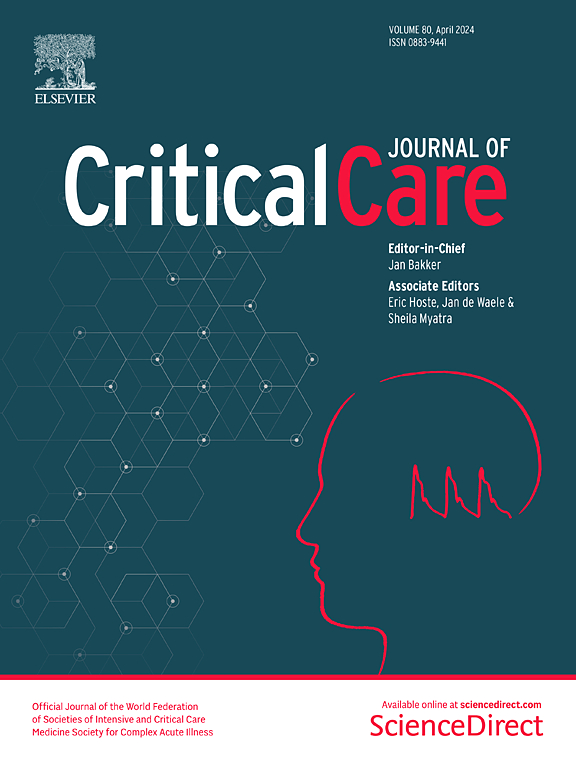外伤性脑损伤后脑灌注压指标的再评估
IF 8.8
1区 医学
Q1 CRITICAL CARE MEDICINE
引用次数: 0
摘要
脑灌注压(CPP)管理是创伤性脑损伤(TBI)后神经危重症护理管理的核心。虽然脑外伤基金会建议的目标是60-70毫米汞柱,但从脑血管自动调节的角度来看,尚不清楚这个范围反映的是下限还是最佳水平。自动调节旨在稳定脑血流量,可使用压力反应指数(PRx)连续估计。个性化的CPP目标可以从PRx中得到,包括CPPopt(最优CPP)、LLA和ULA(自动调节的下限和上限)。新出现的数据表明,在CPPopt周围存在不对称关系,与CPP增加相比,随着CPP降低,自动调节恶化更为明显。基于较高的CPP水平可能比较低的CPP水平危害更小的假设,我们旨在重新严格评估不同CPP指标的预后价值。我们分析了2002年至2023年收治的809例成年TBI患者,他们接受了侵入性颅内压监测,并有6个月的可用结果。CPPopt、LLA和ULA使用以前发表的方法进行估算。评估CPP与固定或个性化目标的偏差,描述总剂量、每小时剂量和在这些目标外停留的时间百分比,并使用卡方检验、逻辑回归、热图、顺序分析和基于组的轨迹建模进行检查。我们的数据证实了CPP/PRx的不对称关系,随着CPP的降低,PRx的急剧增加,CPP的增加只有适度的升高。即使是低于CPPopt的微小下降也与较差的结果一致相关(小时剂量和低于CPPopt的百分比时间的OR分别为1.04 (CI 1.02-1.06)和1.09 (CI 1.04 - 1.15), p < 0.001和p = 0.001)。当CPP从CPPopt向LLA进一步降低时,相关强度增加,小时剂量和低于LLA的时间百分比的OR分别为1.11 (CI 1.07-1.14)和1.26 (CI 1.18-1.35) (p < 0.001)。相反,高于CPPopt水平通常与较差的结果没有关联。CPPopt和LLA(称为下限界限)之间的关系具有明显的轨迹,这些目标之间的距离越小,结果越差(下限界限增加和减少的患者死亡率分别为18%和45%,p = 0.003)。我们的研究结果证实了实验结果,表明与高于个性化阈值相比,TBI患者更容易受到CPP低于阈值的影响。结果强调需要个性化的CPP管理策略,优先避免较低的CPP水平,并建议使用CPPopt作为CPP的下限。本文章由计算机程序翻译,如有差异,请以英文原文为准。
Cerebral perfusion pressure targets after traumatic brain injury: a reappraisal
Cerebral perfusion pressure (CPP) management is central to neurocritical care management after traumatic brain injury (TBI). While the Brain Trauma Foundation recommends a target of 60–70 mmHg, it is unclear whether this range reflects the lower limit or the optimal level, when viewed through the prism of cerebrovascular autoregulation. Autoregulation aims at stabilizing cerebral blood flow and can be estimated continuously using the pressure reactivity index (PRx). Personalized CPP targets can be derived from PRx including CPPopt (optimal CPP), LLA, and ULA (lower and upper limit of autoregulation). Emerging data suggests an asymmetric relationship around CPPopt, with more pronounced autoregulation deterioration with decreasing compared to increasing CPP. Based on the hypothesis that higher CPP levels may be less harmful than lower CPP levels, we aimed to reassess rigorously the prognostic value of the different CPP targets. We analyzed 809 adult TBI patients admitted from 2002 to 2023 who underwent invasive intracranial pressure monitoring and had available 6-month outcomes. CPPopt, LLA, and ULA were estimated using previously published methodologies. Deviations of CPP from fixed or personalized targets were assessed describing the overall dose, the hourly dose and the percentage time spent outside of these targets and examined using Chi-squared tests, logistic regressions, heatmaps, ordinal analyses, and group-based trajectory modelling. Our data confirms an asymmetric CPP/PRx relationship with steeper increases in PRx with decreasing and only modest elevations with increasing CPP. Even small decreases below CPPopt were consistently linked to worse outcomes (OR 1.04 (CI 1.02–1.06) and 1.09 (CI 1.04–1.15) for hourly dose and percentage time spent below CPPopt, p < 0.001 and p = 0.001 respectively). The strength of association increased with further decreases in CPP away from CPPopt towards the LLA with OR of 1.11 (CI 1.07–1.14) and 1.26 (CI 1.18–1.35) for hourly dose and percentage time spent below LLA respectively (p < 0.001). Conversely, higher-than CPPopt levels generally showed no association to worse outcomes. Distinct trajectories in the relationship between CPPopt and LLA (introduced as the Lower Limit Margin) could be identified with worse outcomes in those with decreasing distance between these targets (Mortality of 18% vs. 45% for patients with increasing vs. decreasing lower limit margins, p = 0.003). Our findings corroborate experimental work suggesting that TBI patients are more vulnerable to CPP reductions below as compared to elevations above personalized thresholds. The results highlight the need for individualized CPP management strategies that prioritize avoidance of lower CPP levels and suggest using CPPopt as the lower CPP limit.
求助全文
通过发布文献求助,成功后即可免费获取论文全文。
去求助
来源期刊

Critical Care
医学-危重病医学
CiteScore
20.60
自引率
3.30%
发文量
348
审稿时长
1.5 months
期刊介绍:
Critical Care is an esteemed international medical journal that undergoes a rigorous peer-review process to maintain its high quality standards. Its primary objective is to enhance the healthcare services offered to critically ill patients. To achieve this, the journal focuses on gathering, exchanging, disseminating, and endorsing evidence-based information that is highly relevant to intensivists. By doing so, Critical Care seeks to provide a thorough and inclusive examination of the intensive care field.
 求助内容:
求助内容: 应助结果提醒方式:
应助结果提醒方式:


